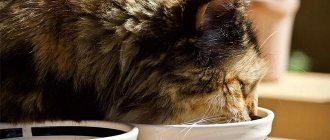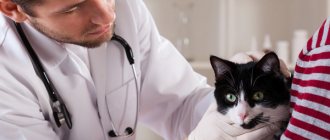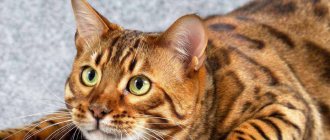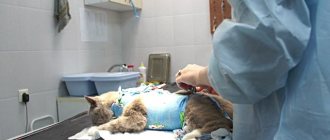Thanks to sterilization, you can not only avoid the appearance of unwanted offspring, but also prevent the development of cancer. The benefits of this operation outweigh the risks, which is why veterinarians strongly recommend it, even before the onset of the first heat.
It is important not to forget that such an intervention in the body requires a mandatory adjustment of the diet. Knowing what you can feed a sterilized cat at home, you can avoid its obesity and other common problems associated with hormonal changes.
Preoperative and postoperative diet
Before a full transition to a new diet, your pet will have to take a fasting day and go on a postoperative diet. With its help, she will be able to prepare her body for the upcoming changes.
Hunger strike before anesthesia
Preparation for general anesthesia includes mandatory refusal to eat 12 hours before surgery. This is necessary in order to prevent sudden attacks of vomiting. Otherwise, the unconscious animal may choke and suffer from aspiration pneumonia. For the same reason, it is recommended to remove the water, but a little later - 3 hours before surgery.
The first day after surgery
Feeding a sterilized cat on the first day after surgery is not provided. She won't have an appetite right after she wakes up, so don't even try to persuade her to eat a big lunch. Instead, offer some water to prevent dehydration.
Please note that only an awakened animal can be given water. Gently wet his lips with a damp cloth or pour a small amount of liquid directly into his mouth using a syringe or dropper. A bowl of water can be given only 3-4 hours after waking up, when the pet becomes more active.
First week after surgery
Food is introduced on the second day, but only when interest appears. If your pet categorically refuses it, you can keep her on a starvation diet for another 1-2 days. All this time she must drink water regularly, since dehydration is much more dangerous than a hunger strike.
All food served should be easily digestible and soft, and the size should be reduced to 1/3 of the normal serving. Focus on the following products:
- wet canned food and spider meat pieces;
- fermented milk products with low fat content;
- lean broths;
- slimy porridges cooked in water.
Harder foods can cause constipation, which can cause your stitches to split. You should also avoid extremely high and low temperatures that irritate the gastric mucosa.
Gradually increase your serving size to get back to normal within a week. Please note that it should not exceed 150 g per day.
Transition to normal food
They return to their usual diet about a week after surgery, but with minor adjustments. In addition to reducing the overall calorie content, you will have to give up a number of dishes familiar to the animal.
With dry feeding everything is much simpler. All standards can be viewed on the packaging, and the composition of such a product excludes the presence of substances harmful and useless to the body. The owner can only decide what kind of food to feed the cat after sterilization, since there are not so few options marked Sterilized.
Unwanted Products
Excessive amounts of magnesium and phosphorus provoke urolithiasis, so food with these microelements is limited. Useless and harmful “dishes” should not be eaten by any cat.
After sterilization, exclude from the diet:
- pollock, cod, and other types of fish are fed boiled no more than 2 times a month;
- sugar, sweets;
- pork;
- legumes;
- oatmeal, semolina;
- smoked meats and sausages;
- potato;
- garlic and onion;
- raw eggs.
Salt also provokes urolithiasis, so do not add salt to dishes.
Why do you need to review the diet of a sterilized cat?
Hormonal changes slow down metabolism, increasing the tendency to obesity. The animal becomes less active and more voracious, so the usual diet can cause rapid weight gain. Also, after the operation, the frequency of urination is reduced, which is fraught with stagnation of urine and subsequent formation of stones - that is, urolithiasis.
Natural cat nutrition after sterilization
In addition to reducing calories and reducing portion sizes, you will need to limit your fat intake in favor of foods enriched with proteins and slow carbohydrates. Knowing what sterilized cats can and cannot eat, you can easily create a new menu without harming the health of your pet.
Authorized Products
For convenience, all permitted products can be sorted by their predominant elements. The most important ones include:
- Squirrels
. Contained in meat (beef, chicken, rabbit, turkey), fish, offal, fermented milk products (yogurt, cottage cheese) and eggs. Such proteins are called animals. Unlike plant foods found in wheat, corn gluten and soybean meal, they are absorbed much faster in the stomach and do not overload the kidneys. Before serving, meat and offal must be thoroughly frozen and boiled to prevent infection by parasites.
- Carbohydrates
. Represented by cereals (buckwheat, oatmeal, rice), vegetables (zucchini, carrots, broccoli) and fruits (apples). Thanks to the high fiber content, they quickly induce a feeling of fullness. Effective in preventing constipation.
- Fats
. Marine fish are enriched with them, but they are not recommended for sterilized animals due to their high phosphorus content. Fish should be replaced with vegetable oils from pumpkin seeds, flax and corn, which have a similar composition.
The percentage ratio of these elements should be 52:12:36 according to the previously specified order. Don't be surprised that the smallest share comes from carbohydrates rather than fats. The thing is that it takes a lot of time to digest them, so in the wild cats receive them in a semi-digested form along with a swallowed rodent.
Prohibited Products
Difficult to digest foods high in fat, magnesium, phosphorus and salt are prohibited. It promotes obesity, causes constipation and provokes the development of urolithiasis.
When reviewing your diet, make sure to avoid feeding the following foods:
- river and sea fish;
- fatty fermented milk products and milk;
- pork;
- semolina, pearl barley and oatmeal;
- onion and garlic;
- raw eggs;
- potatoes and legumes.
It is also prohibited to feed the animal food from your table (smoked meats, sweets, canned food, baked goods, marinades). Human dishes contain large amounts of spices, salt and artificial additives that are intolerable to a cat's stomach.
Supplementation of vitamins from a veterinary pharmacy
Unlike ready-made food for sterilized cats, “natural” food is not able to provide the body with all the necessary elements. For this reason, some vitamins and minerals have to be replenished using ready-made complexes.
Please note that all vitamin and mineral complexes are administered only after consultation with a veterinarian. Independent choice of drugs can result in an overabundance of useful substances.
Feeding with industrial feed
As noted above, food for a sterilized cat must be marked Sterilized. It means that when creating these granules, the restructuring of hormonal levels was taken into account. This food has lower calorie content and eliminates the presence of harmful elements.
When choosing a brand, focus on its quality. Economy-class food is replete with useless plant components and mechanically separated meat, so it’s better to go for premium and holistic food.
Don't forget to study the composition. The quality of the product will be confirmed by:
- high meat content, determined by the location of this ingredient in 1st place;
- absence of flavor enhancers, flavorings and other dubious additives;
- the presence of L-carnitine, which accelerates metabolism, and L-lysine, which preserves muscle mass.
Please note that with natural feeding, 75% of the liquid enters the body from food. If your pet only eats dry food, then the granules give her no more than 10% of the daily moisture requirement.
To prevent dehydration of the body, make sure that the amount of water you drink exceeds the amount of “crackers” you eat by 2 times. The norm may decrease when feeding wet canned food, but should not fall below 20 ml per 1 kg of weight.
Review of recommended brands
The first place undoubtedly belongs to holistic foods such as Go!, Orijen and Acana.
They are distinguished by high quality components and are completely suitable for sterilized cats. The protein content in them is from 40 to 70%. But despite this, pets with kidney problems should not be fed them constantly. The disadvantage of these feeds is their high cost, so before introducing them into the diet, the owner should adequately assess his purchasing power. Suitable food can be selected in the middle price segment:
Purina ProPlan
Purina ProPlan
This food belongs to the premium class. The manufacturer produces a special line for sterilized cats.
It has a high (more than 40%) animal protein content, but it also has disadvantages. Among the ingredients you can see corn and wheat gluten.
On sale you can find not only dry granules and canned food, but also pouches, and the source of proteins is varied. In addition to chicken and turkey, you can choose beef or sea fish food. If your cat has previously eaten food from this brand, it makes sense not to change the manufacturer.
1st Choice
1st Choice
Grain-free food from a popular Canadian manufacturer, produced in a specially developed line for neutered pets.
Not only does it contain a balanced composition of all the necessary nutritional ingredients for a sterilized cat, but it facilitates hair care, ensuring its healthy shine and healthy skin, as well as normal functioning of the gastrointestinal tract and the prevention of obesity.
Its main advantage is that it is low in fat (only 9%), while proteins occupy 33% of the total composition. The source of protein, as a rule, is natural chicken meat. The entire line of flavors belongs to the super-premium class.
Hill's
Hill's
Excellent food from Dutch production. Almost the entire treatment line is suitable for sterilized cats, as it ensures the health of the cat’s urinary and urinary organs.
Available in all types: dry and canned food, spiders with pieces of meat in jelly. Protein source: natural chicken (32%). The disadvantage is the presence of corn gluten in the composition.
Perfect for long-term use, as it has a fairly affordable price.
Royal Canin
Royal Canin
The manufacturer of a well-known brand of food indicates an increased content of high-quality protein, up to 37%.
However, if you look at the composition, the protein source is indicated as dehydrated animal protein (poultry) and plant protein isolate.
Therefore, it remains unclear from what kind of poultry meat it was produced. It also contains wheat, which often causes allergies in pets. The food is highly varied and is available in all varieties: dry granules, pouches, canned food and pates.
It is not recommended to feed your pet with economy-class food such as Kitekat, Whiskas and Friskies. In their production, low quality products are used, so they do not meet the daily needs of a sterilized cat.
Feeding frequency and daily portion size
Having decided what food you will feed the sterilized cat, the owner will be faced with a change in the frequency of feedings and the size of the daily portion. Remember that dry granules cannot be mixed with “natural”. Such a diet can result in indigestion.
Adult animals are fed twice a day at certain times. The interval between feedings should be equal to eliminate the feeling of hunger.
If your pet does not eat enough and constantly wants to eat, divide its daily portion into more meals. After sterilization, she does not control the amount of food she eats and mindlessly swallows everything that is put in her bowl.
The average daily portion size depends on body weight. It is 30 g per 1 kg and is calculated individually. Be sure to monitor your pet’s weight and change the portion size up or down if necessary.
With a weight of 5-8 kg, you will need 150-250 g of feed per day, that is, the amount of recommended products will be as follows:
- meat and offal – 70-120 g;
- fermented milk products – 30-60 g;
- vegetables – 40-50 g;
- cereals – 10-20 g.
If your pet drinks little water, add light broths based on vegetables and meat to her diet. It is also necessary to mix a few drops of vegetable oil into the food. It has a positive effect on digestion and wool quality.
How do you know that an animal gets everything it needs from food?
The correct feeding of a sterilized cat will be determined by its general health, appearance and weight. If your pet is alert and active, does not suffer from constipation or other digestive disorders, its coat looks well-groomed and shiny, and its weight is stable despite its good appetite, then you are doing everything right.
If at least one of these points is violated, the existing food supply must be reconsidered. Please consult your veterinarian for detailed recommendations.
Possible complications
Complications can arise due to the wrong moment for the operation. For example, sterilization cannot be carried out at an early and mature age, during estrus, pregnancy and during the feeding period of kittens.
During the postoperative period, your cat may have no appetite, prolonged lethargy, or difficulty defecating.
Therefore, you should be attentive to your pet and pay attention to any seemingly insignificant signs:
- If the cat has recovered from anesthesia, but does not move, and its ears and paws are cold.
- Bloody marks on the seam or pale skin. These are signs of intra-abdominal bleeding.
- Temperature above 39 or below 37 degrees.
- The mucous membranes have turned pale or red.
When faced with any complication from this list, the best thing to do is to immediately contact a specialist. There is no need to ignore the symptoms and try to self-medicate. The only thing a cat needs from its owner is proper care. Otherwise, there is a risk of a hernia or wound suppuration.
Tendency to obesity and how to deal with it
Food for a sterilized cat is not a panacea. You can get fat on it if you don’t follow feeding standards and don’t monitor physical activity.
If your pet is steadily gaining weight, reduce its daily portion by increasing the number of meals to 4-5 times a day. Fractional meals effectively combat hunger and improve metabolism.
Also don't forget about active games. If you don’t have enough time, buy educational toys that your pet can play with independently. In any case, weight loss will not happen by itself - the owner will have to do it.
Conclusion
A balanced diet for a sterilized cat is the key to its health and long life, so pay special attention to this point. Don’t skimp on the freshness of natural products and the quality of dry food to provide your pet with all the necessary elements. And don’t forget that after the operation you will have to monitor your mustachioed pet’s weight even more closely than usual.
The article is a recommendation!
Causes of increased appetite
After surgery, cats need a diet. You can check with your veterinarian for the most beneficial diet for your pet.
In addition to the described consequences of sterilization, there is another one, which not all owners report - this is increased appetite. Previously, cats had developed two instincts: reproduction and saturation. After sterilization, the need to find a partner and raise offspring disappears, and the cat devotes all its energy to the remaining instinct. Cats often cannot restrain themselves in terms of food restriction, and will eat all the food, no matter how much there is in the bowl. And therefore, it is correct to feed a sterilized cat, limiting its diet (or rather, do not fill the bowl as soon as it is empty), otherwise there is a high risk that your cat will become obese, and this is fraught with additional health problems.











